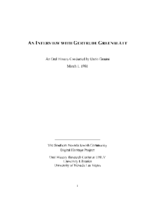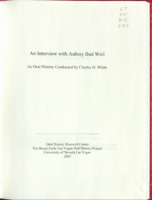Search the Special Collections and Archives Portal
Search Results

Transcript of interview with Gertrude Greenblatt by Dario Gratini, March 1, 1981
Date
Archival Collection
Description
Interview with Gertrude Greenblatt by Dario Gratini on March 1, 1981. In this interview Greenblatt talks about arriving in Las Vegas in the 1940s, and the changes that took place place such as population growth, price increases, employment requirements, and recreation. She also talks about the changes in utilities and environmental issues.
Text
Josephine Bruns oral history interview
Identifier
Abstract
Oral history interview with Josephine Bruns conducted by Christopher Wong on March 9, 1975 and March 12, 1975 for the Ralph Roske Oral History Project on Early Las Vegas. Bruns discusses her family background, recreational activities, transportation, entertainment, and the growth of businesses in Las Vegas, Nevada. Bruns also talks about the Stewart Ranch and the Union Pacific Railroad.
Archival Collection

Transcript of interview with Edward Gregory by Jonathan Bellingar, March 2, 1977
Date
Archival Collection
Description
On March 2, 1977, Jonathan R. Bellingar interviewed Edward Gregory (born July 28, 1922) about his life in Nevada. The interview takes place at Nellis Air force Base; also present during the interview is an unidentified man. Gregory was born and raised in Nevada; he discusses leaving Nevada to serve in the Army during World War II before eventually returning to Nevada in 1950. The interview concludes with a brief overview of how Nellis Air force Base has changed since the 1950s.
Text
Ina Porter oral history interview
Identifier
Abstract
Oral history interview with Ina Porter conducted by Claytee White on January 05, 2010 for the Voices of the Historic John S. Park neighborhood oral history project. Porter recalls moving to the John S. Park Neighborhood in the 1940s. She describes how they helped build the Mormon Church and the importance of the Latter Day Saints Church to the John S. Park Neighborhood. Lastly, Porter discusses the changes in the John S. Park Neighborhood over fifty years.
Archival Collection
Joseph Thiriot oral history interview
Identifier
Abstract
Oral history interview with Joseph Thiriot conducted by Claytee D. White on August 10, 2000 for the Boyer Early Las Vegas Oral History Project. Thiriot discusses his vivid memories of moving around, including living in Idaho where his father sold an invention that was a forerunner to the typewriter. He also talks about working as a high school teacher.
Archival Collection
Interview with Edith Allan
Identifier
Abstract
Oral history interview with Edith Allan conducted by Elizabeth Cleary on February 26, 1977 for the Ralph Roske Oral History Project on Early Las Vegas. Allan discusses living on a dairy farm, as well as her experiences working for Western Union and the Sal Sagev Hotel. Allan also mentions the building of Hoover Dam, Block 16, and the Stewart Ranch.
Archival Collection

Transcript of interview with Bud Weil by Claytee White, December 9, 2003
Date
Archival Collection
Description
Bud Weil worked as a disc jockey in Mexico after serving in the military during World War II. In 1947, he moved to Las Vegas to work at KLAS but after two days he was job hunting. His search landed him at KENO, a radio station owned by Max and Laura Belle Kelch. His was an interview show that afforded him entree to stars performing in town. The list of his favorite interviews includes Sophie Tucker, Sammy Davis, Jack Benny, The Mills Brother, Rosemary Clooney, Leno Home, Joey Lewis and many others. In 1955, he became restless, left the career in broadcasting, and joined Max Kelch as a partner in a new venture for Las Vegas - Musak. This enterprise took him to the doors of every business in town and shortly, he knew everybody. He uses that knowledge in this interview to talk about all aspects of life as the town grew over the years. Today he is a senior statesman of our town, enjoying everything about Las Vegas except the traffic.
Text
Gary B. Hafen oral history interview
Identifier
Abstract
Oral history interview with Gary B. Hafen conducted by Christopher McEntire on April 30, 2002 for the Public School Principalship Oral History Project. In this interview, Hafen reflects upon his 30-year career as a teacher and administrator with Nevada’s White Pine County School District and the Clark County School District from 1959 to 1989. He describes his approach to administration, his experience with school integration, and the importance of being present for students, parents, and teachers throughout the day. He also discusses what he believes makes a successful principal and school administrator, and describes the roles that teachers, assistant principals, and principals play in operating a school.
Archival Collection

Transcript of interview with Dick Chapter by Stan Hawkins, March 6, 1979
Date
Archival Collection
Description
On March 6, 1979, Stan Hawkins interviewed furniture refinisher, Richard T. Chapter (born January 28th, 1933 in Maine) at his home in Las Vegas, Nevada. During the interview, Richard recalls swimming at the old ranch, going into the furniture refinishing business, and the cost of living in Las Vegas. He also discusses Howard Hughes, the Boulder Dam, and the Union Pacific Railroad. Richard’s wife is also present during the interview and interjects comments about the old Mormon Fort, gambling, local business, and the weather in Las Vegas.
Text
Greg Phelps oral history interview
Identifier
Abstract
Oral history interview with Greg Phelps conducted by Claytee D. White on November 15, 2017 for the Remembering 1 October Oral History Project. Greg Phelps discusses moving to Las Vegas, Nevada in 2002 for work and attending the 2017 Route 91 Harvest festival with his mother and wife. He describes the event venue as well as his recollection of the shooting. Phelps explains how his life changed after that day, describing the true friendships he gained and his greater appreciation for living.
Archival Collection
